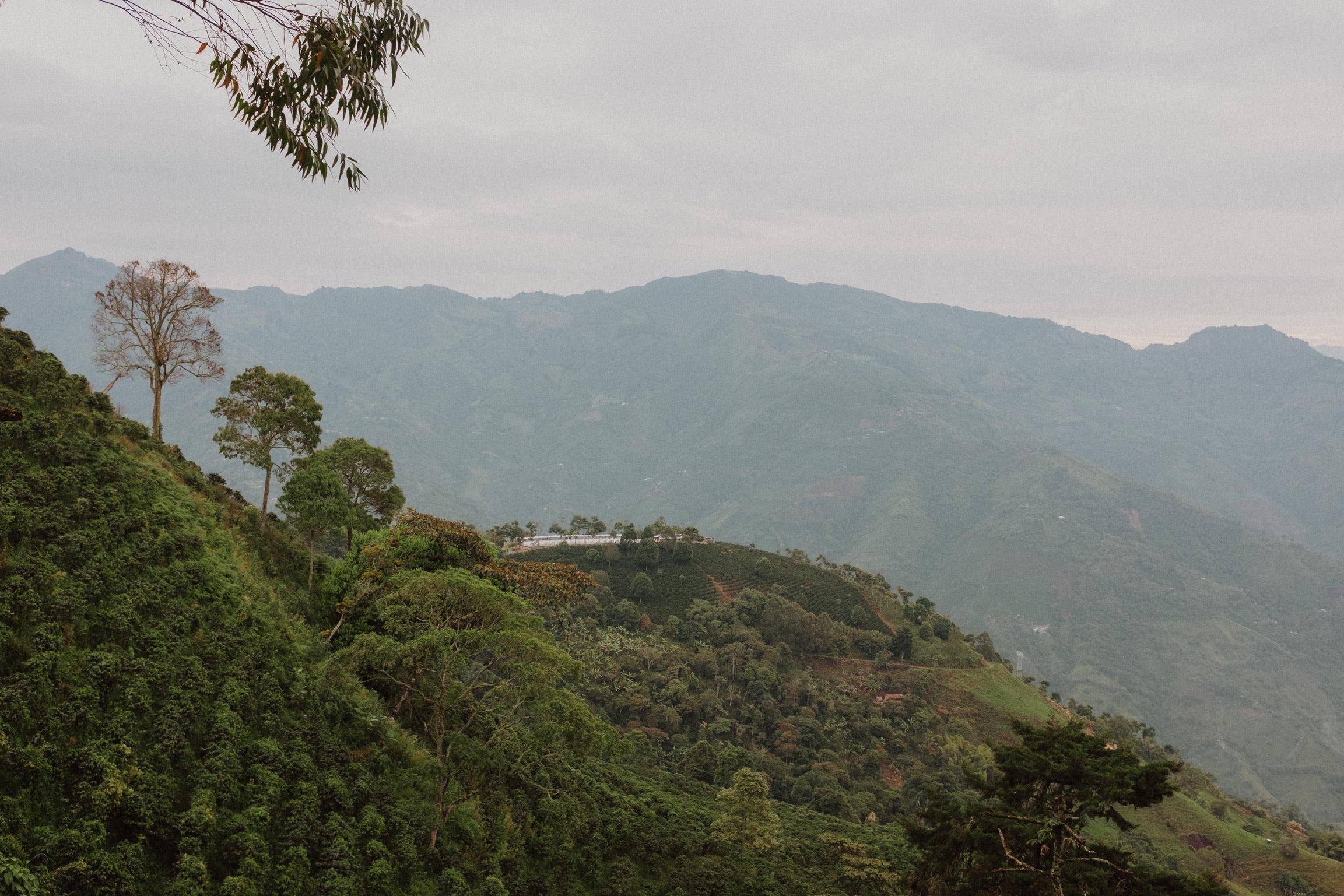
Agronomy
The process begins with a seed (the coffee bean itself) planted in sand, where it germinates into a small seedling called a “chapola.” After 3 months, the seedling is transplanted into a small bag, and continues to grow until it is strong enough to be planted in the field.
Once the tree has been planted, it can take up to 2 years to produce its first harvest. Its production cycle typically lasts 6 years before it is replaced with a fresh plant, or pruned for regeneration. Regeneration occurs when the trunk of an unproductive tree is cut at a height of 30 cm off the ground. From this stump grow several new shoots, two of which are selected to develop into a new tree that will produce coffee for another 6 years. Farming practices vary from country to country and change over time. Previously in Colombia, trees were harvested for dozens of years before being replaced or pruned.
For a tree to produce coffee cherries, it first needs to bloom. Flowering usually occurs after an intense dry period, during which hydric stress triggers the tree’s reproductive process to ensure the continuation of its lineage. The flower is shed within a few days, leaving behind a small fruit that matures over the course of 7 to 9 months.

Within this latitudinal range, a tree’s altitude is also determinant of its final quality. In Colombia, coffee is grown between 1,200 and 2,200 meters. The higher the altitude, the colder the climate — and the slower the maturation of the fruit. Slower maturation means that fruit are denser, preserving vital components within their cell walls that are responsible for aroma. The ideal temperature range for the maturation of coffee fruit is between 63 and 73 degrees Fahrenheit. Higher altitude also means fewer pests, making it possible to grow varieties that produce an exceptional final cup, but are more susceptible to diseases.
Soil quality is also critical. Soil must be rich in organic matter, and a number of minor and major elements, in order to provide the “balanced diet” coffee cherries need to flourish and develop exceptional aromatic complexity.
Common pests and diseases
-
Coffee Rust
Coffee rust is considered one of the most catastrophic plant diseases in history. It is among the seven pests and diseases that have caused the most devastation in the past 100 years of coffee cultivation. It consists of a spore that attacks the leaves of the plant, defoliating the tree and preventing photosynthesis.
-
Coffee Boar
This small, vicious beetle attacks coffee plants after the first 40 or 60 days of flowering, damaging the fruit. Depending on the temperature, its life cycle lasts between 35 and 100 days. It is unable to survive in heat above 45 degrees.
-
Red Spider
The red spider voraciously attacks the green leaves of coffee trees, causing a reddish or tan discoloration, until they eventually wilt and fall off.
Seguir Leyendo
-

01. Introduction
See moreWe are privileged to work in every stage of the coffee process — from farm to cup.
-

02. What are specialty coffees?
See moreWe’ll begin by defining specialty coffees — and what differentiates them from lower-quality beans.
-

03. Describing coffee
See moreCoffee is like wine. There’s the gas-station kind that taste like sludge, the critically-acclaimed kind that experts and hipsters alike hail as tasting like bouquets of flowers — and everything in between.
-

04. Agronomy
See moreThe process begins with a seed (the coffee bean itself) planted in sand, where it germinates into a small seedling called a “chapola.” After 3 months, the seedling is transplanted into a small bag, and continues to grow until it is strong enough to be planted in the field.
-

05. Farm processing
See moreRemember that the coffee we consume is the roasted seed of a fruit. The fruit begins its process of transformation when it is picked from the tree. Unlike other fruits (such as banana, avocado, mango, etc.), coffee can’t be picked while it is still green. It must be harvested at the perfect point of ripeness, when the cherry has fully matured.
-

06. Roasting
See moreAt Pergamino, we are artisanal roasters. is means several things. First, that we roast in small batches under the careful oversight of a master roaster. We analyze each batch of green coffee in depth in order to determine the ideal roasting curve for its density, profile and final destination.
-

07. Species of trees
See moreAt Pergamino, we are artisanal roasters. is means several things. First, that we roast in small batches under the careful oversight of a master roaster. We analyze each batch of green coffee in depth in order to determine the ideal roasting curve for its density, profile and final destination.
-

08. Extraction theory
See moreAs you can see, behind each cup of coffee is a world of complexity — meaning that we have a huge responsibility at the moment of the final brew. At Pergamino, we are very proud of our team of baristas, who assume this responsibility with great professionalism. They receive constant training, not only in the preparation of our drinks, but in the entire backstory of our coffees, and how to pass on their unique stories to our customers. But do not worry — with a little discipline and curiosity, you, too, can learn to make excellent coffee at home!
-

09. Preparation of filtered coffee
See moreBefore going into detail about brewing, we’d like to cover the core principles of coffee extraction. Brewing coffee is always a delicate game — balancing the quantity of coffee, the quantity of water, the type of grind, and the extraction time. Depending on the method, these factors can be varied in order to highlight specific attributes of a coffee.
-

10. History
See moreCoffee’s global voyage began in the lush highlands of Ethiopia, the original motherland of the Coffea Arabica plant. The earliest known writing on the coffee plant, dating to the 10th century, characterizes it as a medicine—prepared as an infusion of coffee cherries in hot water.
-

11. The Allied Farmers Project
See moreLike all small, medium and large producers in Colombia, Pergamino spent many years helplessly riding the roller coaster of international coffee prices. We had to invest in our crops without knowing what they would sell for during their 12-year production cycle.
-

12. Dreams of the future
See moreWe dare to share with you a dream that we have for the future. Colombian coffee has changed a lot in the last 80 years, shifting towards more technical, large-scale cultivation — with widespread use of chemical fertilizers, pesticides, monoculture, and complete exposure (without shade trees).
-

13. Brewing methods
See moreThese are our favorite methods and advices
-

Navidad (500g bag)
Allied producers across Colombia
Regular price $18.99Regular priceUnit price / per -

Special Edition, Gesha Convite (360g bag)
Inzá, Cauca
Regular price $26.99Regular priceUnit price / per -

Three-Origin Kit (500g bag) - 10% off
Allied producers across Colombia
Regular price $49.47Regular priceUnit price / per -

Lomaverde (500g bag)
Santa Bárbara, Antioquia
Regular price $16.99Regular priceUnit price / per




















